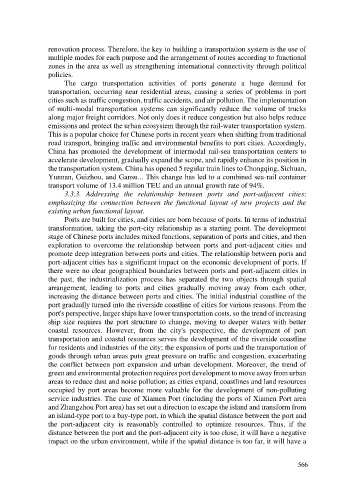Page 574 - Ebook HTKH 2024
P. 574
renovation process. Therefore, the key to building a transportation system is the use of
multiple modes for each purpose and the arrangement of routes according to functional
zones in the area as well as strengthening international connectivity through political
policies.
The cargo transportation activities of ports generate a huge demand for
transportation, occurring near residential areas, causing a series of problems in port
cities such as traffic congestion, traffic accidents, and air pollution. The implementation
of multi-modal transportation systems can significantly reduce the volume of trucks
along major freight corridors. Not only does it reduce congestion but also helps reduce
emissions and protect the urban ecosystem through the rail-water transportation system.
This is a popular choice for Chinese ports in recent years when shifting from traditional
road transport, bringing traffic and environmental benefits to port cities. Accordingly,
China has promoted the development of intermodal rail-sea transportation centers to
accelerate development, gradually expand the scope, and rapidly enhance its position in
the transportation system. China has opened 5 regular train lines to Chongqing, Sichuan,
Yunnan, Guizhou, and Gansu... This change has led to a combined sea-rail container
transport volume of 13.4 million TEU and an annual growth rate of 94%.
3.3.3. Addressing the relationship between ports and port-adjacent cities:
emphasizing the connection between the functional layout of new projects and the
existing urban functional layout.
Ports are built for cities, and cities are born because of ports. In terms of industrial
transformation, taking the port-city relationship as a starting point. The development
stage of Chinese ports includes mixed functions, separation of ports and cities, and then
exploration to overcome the relationship between ports and port-adjacent cities and
promote deep integration between ports and cities. The relationship between ports and
port-adjacent cities has a significant impact on the economic development of ports. If
there were no clear geographical boundaries between ports and port-adjacent cities in
the past, the industrialization process has separated the two objects through spatial
arrangement, leading to ports and cities gradually moving away from each other,
increasing the distance between ports and cities. The initial industrial coastline of the
port gradually turned into the riverside coastline of cities for various reasons. From the
port's perspective, larger ships have lower transportation costs, so the trend of increasing
ship size requires the port structure to change, moving to deeper waters with better
coastal resources. However, from the city's perspective, the development of port
transportation and coastal resources serves the development of the riverside coastline
for residents and industries of the city; the expansion of ports and the transportation of
goods through urban areas puts great pressure on traffic and congestion, exacerbating
the conflict between port expansion and urban development. Moreover, the trend of
green and environmental protection requires port development to move away from urban
areas to reduce dust and noise pollution; as cities expand, coastlines and land resources
occupied by port areas become more valuable for the development of non-polluting
service industries. The case of Xiamen Port (including the ports of Xiamen Port area
and Zhangzhou Port area) has set out a direction to escape the island and transform from
an island-type port to a bay-type port, in which the spatial distance between the port and
the port-adjacent city is reasonably controlled to optimize resources. Thus, if the
distance between the port and the port-adjacent city is too close, it will have a negative
impact on the urban environment, while if the spatial distance is too far, it will have a
566

